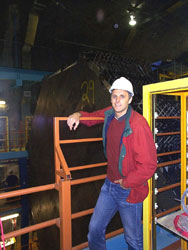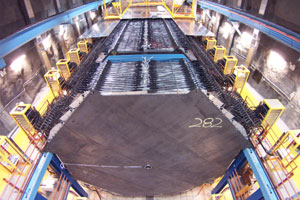Scientists go underground in hunt for elusive neutrinos

Dr Philip Harris surveys the neutrino detector project at the Soudan mine in Minnesota, USA
A major experiment that will see University of Sussex scientists investigating one of physics' most intriguing puzzles has been launched in the USA.
Scientists and politicians from the six countries involved in the MINOS (Main Injector Neutrino Oscillation Search) project gathered at the Fermi National Accelerator Laboratory (Fermilab), near Chicago, for the start of the experiment, which has taken ten years to develop.
A beam of sub-atomic particles called neutrinos was activated and sent straight through the earth from Fermilab to a 5,400-ton detector 400 miles away in an underground cavern in Minnesota.
The detector itself, whose 200,000 readout channels are calibrated by an innovative system developed at Sussex, is a massive "sandwich" of 486 hexagonal steel plates, 8m wide and 2.5cm thick, interleaved with special plastic sheets that emit tiny flashes of light when charged particles pass through. Of the many billions of ghost-like neutrinos that will stream through the detector, just a few will interact and reveal their presence, allowing them to be studied in exquisite detail.
It is then that the work of a team of Sussex physicists, led by husband and wife Dr Phil Harris and Dr Elisabeth Falk Harris, begins in earnest.

An overhead view of the giant plates that make up the neutrino detector in the Soudan mine, Minnesota
"The past seven years have seen a revolution in neutrino physics," says Lisa. "Originally, neutrinos were thought to be mass-less, but we now know that that isn't the case. Tiny though they are, there are so many of them out there that their total mass is likely to equal the mass of all of the ordinary matter in the Universe. In addition, they exhibit the most extraordinary behaviour - due to a quirk of quantum mechanics, the fact that they have slightly different masses allows the three distinct types of neutrinos to transmute from one to another as they travel along. This so-called oscillation is the property that we'll be studying with unprecedented precision."
Phil adds: "The nature of neutrinos is one of the hottest topics in physics today, and the experiment should help to unravel their mystery. This is a very exciting time for all of us: After so many years developing and building this experiment together, we're really looking forward to seeing our first results. We're now in uncharted territory, but within a year the answers we've been waiting for will start to come in."
Professor Ian Halliday, CEO of the UK's Particle Physics and Astronomy Research Council, which has funded the UK part of the project, says. "I'm extremely proud that UK scientists have played a key role in bringing this experiment to fruition and, in collaboration with their international colleagues, will be amongst the first in the world to study its unique characteristics"
Other UK institutions working on the project are: Oxford, Cambridge, University College London and CCLRC Rutherford Appleton Laboratory in Oxfordshire. The experiment was launched at a formal dedication on Friday, 4 March, 2005.
Notes for editors
For more about the MINOS project, see http://www.fnal.gov/ or for an up-to-date view of what's happening now, see http://farweb.minos-soudan.org/events/LiveEvent.html
University of Sussex Press office contacts: Maggie Clune or Jacqui Bealing, tel: 01273 678 888 or email M.T.Clune@sussex.ac.uk or J.A.Bealing@sussex.ac.uk
Useful links
Information for Journalists Previous press releases